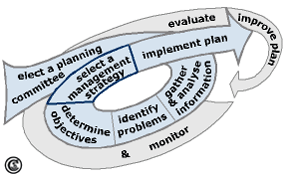Selection of a Watershed Management Strategy
Selection of a watershed management strategy within the Watershed Management planning process
Image Credit: after data from Heathcote 1998
The next planning step is to select a reasoned watershed management strategy in order to achieve the determined objectives. This is a crucial step which includes several tasks for the planning committee:
- determination of constraints (e.g., budget), decision criteria (e.g., probable life of structures) and criteria weights;
- determination of a method to compare management alternatives (screening method); these can be very simple ones such as graphical matrixes or more complex ones such as simulation models which show the impacts of each alternative)
- developing a long list of possible management options on the basis of the watershed inventory (e.g. contour ploughing or terraces discussed in soil and water conservation; but this is only a selection!); compilation of a list of possible management strategies which are composed of the individual options and their combinations.
- elimination of options by criteria (e.g., if too expensive).
- testing of the remaining feasible options by application of the determined screening methods and decision criteria (Heathcote 1998);
- choosing the best management strategy;
- putting together an action plan, a list of measures for implementing the selected alternatives; usually these will fall into four types: information/education, technical assistance, funding and regulatory (EAP 2002).
The measures that are actually implemented locally are called implementation tools. The watershed management strategy selected for the Gina River catchment is presented on the following page.
